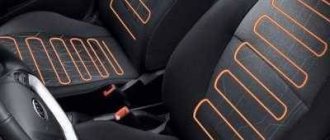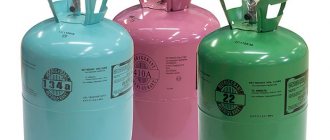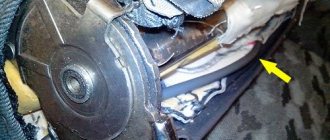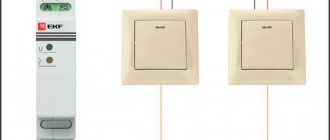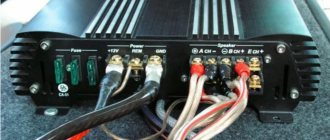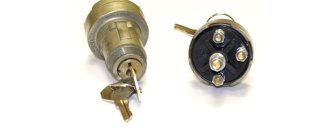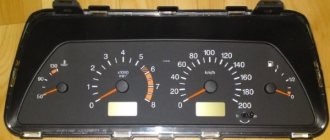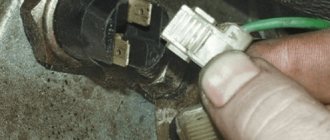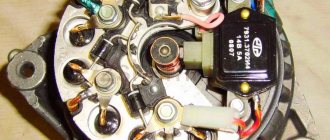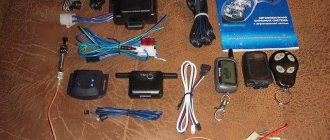5Best seat heaters
Seat heating is a must to ensure a comfortable car ride in winter. Typically, such systems are installed in premium cars. But there is an alternative. Seat pads and interior devices can be purchased separately. There are a large number of models with different characteristics and mounting methods.
In the modern automotive market, it is difficult to choose a high-quality and durable product. Therefore, it is important to carefully approach the choice. You need to find out about the compatibility of the heating with the car. Before purchasing, you should pay attention to reviews and positive aspects of the product.
We have compiled a list of the best heated seats based on expert assessments and reviews from real customers. Our recommendations will help you make a choice that suits your needs and desires. There are many competitors in the global technology market, but we have selected the best manufacturers and recommend paying special attention to them:
- Emelya
- AIRLINE
- SKYWAY
Categories Type: Installation Kit Type: Cape Type: Case Material: Fabric Heater: Carbon Fiber With Controller Material: Polyester
| 1 | Emelya UK1/UK2/UK3 | RUB 4,380 |
| 2 | AIRLINE AHC-SF-03 | RUB 1,250 |
| 3 | Emelya 2/3 | RUB 1,150 |
| 4 | MagicComfort MH-40GS | RUB 1,990 |
| 5 | SKYWAY series S022020 | RUB 1,250 |
*Prices are correct at the time of publication and are subject to change without notice.
The winter season brings its own adjustments to the lives of car enthusiasts. And the point here is not only the need to purchase appropriate tires or the need to periodically recharge the battery. Sitting down in the cold seat of your car in the morning, you will agree, is a pleasure that, in terms of the amount of adrenaline released, is more suitable for extreme sports enthusiasts.
Most of us are not one of those, but at the same time, not everyone owns models with a full package of options. This raises the question of how to choose heated seats for a car and correctly connect the equipment. The right choice will make you feel much more comfortable behind the wheel, which will immediately affect the safety and health of the driver and his passengers.
Types of seat heating
There are 2 ways to heat the seats:
- slip-on, removable (can be in a case, can be separate);
- built-in
Snap-on or removable heaters can be sold together with covers; the heating elements are glued to the seat and backrest. Also, there may be removable heaters that are simply thrown over the chair and connected to the cigarette lighter or through a specially installed button.
As for the built-in heating, it is installed in the seat upholstery and does not depend on the cover. The most popular type is a built-in heater.
Classification of heating kits for car seats
- External ones - made in the form of covers and capes, secured with belts and connected to the cigarette lighter socket.
- Built-in - mounted under the upholstery of the seat and connected to the vehicle's on-board network.
Each of the options has every chance of being purchased; the only question is the financial capabilities of the owner and his technical skills. In addition, it is worthwhile to dwell in more detail on the design features of each type of heating systems, their advantages and disadvantages, and also consider popular examples of these accessories.
- Installation of heated seats, connection diagram
Operating principle of heated seats
Built-in heaters can be standard, installed at the factory, or you can do it yourself. It must be installed between the casing and the foam layer. Carbon fiber fabric or reinforced wiring is used as materials for the manufacture of preheaters. They are sold immediately in mats. You can also use a separate spiral. These materials have their pros and cons. The nichrome spiral used has the advantage of not having a high price. When installing such a spiral, you need to ensure that the heating element does not touch the fittings. But, with the help of double-sided tape this can be easily done.
Mats made of carbon fiber or reinforced wires have no restrictions, you can just lay them well and that’s it. They cost more than just a spiral, but are more reliable.
The fastest way to heat your seats: a heating blanket
The cheapest and least labor-intensive way to heat seats is a cape with this very function. It can be found online:
and in specialized stores, where there are many similar products in different versions for different car models with different seats. The cape installs in seconds and is typically powered from a 12-volt “cigarette lighter” outlet. Installation does not require any special knowledge or skills. Straighten the cover on the seat, secure it with the straps according to the instructions.
The only thing you should make sure is that the pads fit your car seat, are well secured and, if possible, do not slip. Next, plug the plug into the cigarette lighter - and the heating element begins to work its magic, pull out the plug from the 12-volt socket - and the pillow stops heating:
How to make heated seats on a VAZ 2110 without contacting a service center
seat heating "Emelya 2" pros and cons
Video taken from the YouTube channel MrCAHEK87
There are, of course, more “sophisticated” versions of heating covers, with multi-phase regulators, beautiful appearance and even massage and cooling functions... But they still will not be as comfortable as seats with built-in heating, cooling and massage, they will break down more often , and these multifunctional covers are not cheap at all: 5-9 thousand as standard, in contrast to the same covers with a single heating function, which can be bought for 1,000-2,500 rubles.
Caution: The seat pad must not overlap the side airbags.
Pros and cons of heaters
There are several advantages of a built-in car seat warmer. This:
- From the outside it is not noticeable that there is a heater. If you use cap heating, the interior design may not be affected.
- The power source is a special unit. This has the advantage that the cigarette lighter socket remains free.
- The thermal relay controls the temperature, monitors the degree of heating of the coil so that it does not exceed the permissible heating temperature and does not ignite the seat.
- You can choose any location for the control unit.
- Can be installed on any seat in the cabin.
The disadvantage of built-in heating is the cost. The price of the built-in one is higher than the captive one. But, all the same, it is better to buy a built-in seat heater, it is more reliable.
Heating control
The heater is connected to the computer unit of the machine. You can choose operating modes, heat up as quickly as possible, or with average temperature. The driver can set the temperature, when heated to which, the heating turns off automatically. Some modifications of such heaters have a timer function that will turn the device on and off according to specified parameters.
Built-in heaters have the option of accelerating heating, and then switching to standby mode. If you need such heating, then you need to take it with two heating elements.
Depending on the models of car seat heaters, there are different operating modes, some even have up to 8 modes.
What types of heated seats are there?
There are 2 types of seat heating kits: with a copper heating element and with a carbon fiber heating element (carbon fiber/carbon thread).
Seat heating kits are available in 12V and 24V versions.
Seat heating kit with copper wire heating element
A seat heater with a copper heating element is one long zigzag wire where one end has a positive polarity and the other end has a negative polarity, similar to the filament in a light bulb, which also gets hot.
Heated seats with a copper heating element have the following advantages:
- The copper heating element heats up quickly.
- Heated seats with a copper wire heating element reach a higher temperature than carbon fiber ones.
Disadvantages of heating with a copper heating element:
- The disadvantage is that the rapid heating and cooling cycles will thin the wire and eventually it will burn out.
- Since the copper wire heating element cannot be cut to fit any seat, there are no universal kits that will fit all vehicles. Various sets with a copper heating element are sold for specific car models, or for specific seat sizes. If you are going to install a seat warmer kit with a wire heating element, it must be designed specifically for your car model (to fit), or be smaller than the car seats.
Seat heating kit with carbon fiber heating element (carbon fiber/carbon thread)
The carbon fiber (carbon fiber) heating element has a honeycomb structure. Electrodes (positive and negative) are located at the edges of the heating pad, cells made of carbon fiber are located between these electrodes.
Sets with a carbon heating element have many advantages:
- The heating element of such heating is a carbon (carbon fiber) thread, which is much stronger than copper wire.
- The honeycomb structure makes the heating substrate very reliable. Damage to a single cell does not disable the functionality of the entire heating system.
- Heating elements in the form of carbon fiber can be trimmed with scissors to reduce the size and fit it to a specific seat. This makes the seat heating kit with carbon heating element universal.
Disadvantages of sets with a carbon heating element:
- Carbon filament takes longer to heat up (about 1-2 minutes longer than a copper wire heating element).
- The carbon heating element heats up to a lower temperature (about 5 degrees lower than the copper heating element).
- Heating with carbon wire reaches the highest temperature of 50-57 degrees and the lowest 43-51 degrees Celsius, which is slightly lower than the copper wire element.
As can be seen from the listed advantages and disadvantages, heated seats with a carbon heating element are more preferable, as they are a universal and reliable option. In addition to universal kits, you can also find a seat heating kit specifically for your car on sale. It will fully match the seat configuration of your car, and will have detailed instructions for connecting to your vehicle. The universal kit may need to be adjusted to the location by trimming the lining with heating elements.
Good heated seats
As is the case with other devices, some are popular and some are not so popular. Here is a list of the 4 best seat heaters:
- Waeco MagicComfort MSH-300 (Waeco Magic Comfort). Consists of a carbon element, an electronic control unit (ECU). Has three heating temperature modes. The kit also includes wires and buttons.
- Emelya UK-2. It consists of a canvas (special electrical wiring laid in a snake), a rotary control unit. There are 8 heating modes. Has protection against short circuit (SC) and sparks.
- Emelya UK. Inexpensive option compared to others. It has a control button for two modes and a built-in sensor.
- Throne. Its heating element is thermal fiber. The fabric frame has a layer of glue to make installation easy.
According to reviews, Waeco heating is the best among built-in models. Vaeko is manufactured in Germany. Simple and reliable, but the price is higher than that of competitors. Suitable for all makes and models of cars.
From the analogue average price category, you can choose auto products from Russian manufacturers. Among domestic heaters, the most popular brand is EMELYA produced by the Teplodom company. One set includes two pieces. Rear seats must be purchased separately.
Heated seats: benefit or harm?
Since its introduction, heated seats have caused a lot of controversy. On the one hand, the usefulness of this option is difficult to underestimate: sitting on a cold leather seat in winter is just as “useful” and “pleasant” as, say, on a stone parapet. At a minimum, a common cold, and, at a maximum, diseases of the kidneys and reproductive system are guaranteed. To preserve the health of the driver and passengers, heated seats are installed.
By the way, many European and American insurance companies, when issuing a medical policy, introduce increasing coefficients for those clients whose cars do not have this option, since they are more likely to catch a cold or develop chronic diseases.
However, doctors say that heated seats can also have a negative impact on health. Excessive use of heating turns out to be dangerous for men's health and can lead to impotence and infertility. In this regard, experts recommend using heating less often, especially if we are talking about a fabric interior rather than a leather one: such a coating itself will quickly heat up with human heat. Some automakers, caring about the health of customers, offer an additional option - a special sensor that forcibly turns off the heated seats after a certain time.
Safety regulations
Although it is written in the device instructions that they are reliable and protected from sparks and fire, you should still be careful when operating:
- do not place objects on the seats that could damage the seat upholstery, for example, something sharp;
- if the seat is wet, for example, the interior has been completely washed, then it is forbidden to turn on the heater;
- when the heating is on, do not place blankets, bags, etc. on the seats;
- You can install Waeco yourself, but if you are not sure that you will do it correctly, it is better to watch the video, study all the intricacies, or contact the service.
Alternatives to tube heaters
Due to the relatively poor quality of the materials of the seat covers, there were cases when the cover caught fire. Heating capes can heat up to 40 degrees, but this is not highly recommended.
Attention! Do not turn on the heating at a high temperature; heating the groin area in men can affect men's health and reproductive function may be impaired.
When choosing a plug-on option, in order to connect other seats, you need to buy an adapter for the cigarette lighter.
Video
How to install heated seats on a BMW X5 (BMW X5).
How to install a seat heater.
Heated seats from Aliexpress.
About heating Emelya 3.
Publication date: October 05, 2021. Category: Automotive equipment.
Car owners spend a huge amount of time behind the wheel of their car, so comfort plays an important role. During frosts, sitting on a cold seat is not the best thing to do, since the standard car heating is not always enough to fully warm up, especially when you need to get into a frozen cabin early in the morning. Heated seats are an excellent solution to this problem.
There are two types of such heating systems: external or external (covers and capes) and built-in (mounted under the upholstery of seats). To figure out which seat heating is better, it’s worth considering the features of these varieties in more detail.
DIY seat heating installation
Before you start installing it yourself, you should pay attention to the operating mode switch buttons included in the kit, or more precisely to their size and method of fastening. The button from the kit may not fit into the standard place on the panel, and you may have to either purchase the required number of buttons suitable for a particular car, or choose a different location for installation. Options for buttons and installation locations can be seen in the photo:
Despite the fact that high-quality kits have reliable protection, it is better to be extra safe and install a fuse. In this case, the on-board network will not be affected if the heating fails. The connection diagram is usually included, but if necessary, it can be found on the Internet. For example, below is a typical diagram for VAZ 2110-12 cars.
The installation of seat heating begins with the installation of heating elements under the seat trim. This is the most difficult stage of the work, since you will have to completely remove the casing in order to properly install the heaters. For an untrained driver, one seat usually takes about four hours. Installing heating elements in the rear seats takes about the same time.
Connecting heated seats, as a rule, does not cause any special problems. The diagram provided by the manufacturer is quite detailed and understandable even for beginners.
One kit allows you to install heated seats for the driver and front passenger. If you also need heated rear seats, you will have to buy another set. The connection diagram will remain the same, i.e. Installation will not cause any additional difficulties.
What else is worth reading
Dual zone climate control
Do-it-yourself heated steering wheel
DIY snow chains
Anti-rain
Climatic
External seat heating
This is the cheapest option, which is most often used by drivers if the car manufacturer has not taken care of heated seats for the car. Covers and capes are equipped with heating elements:
- carbon fiber wiring;
- nichrome spirals covered with a polyvinyl chloride sheath;
- Teflon coated wires;
- Fiber Thermetics thermal fiber.
The power of heating elements of this type ranges from 40 to 100 W with a current consumption of 4-8 Amps. External heaters operate from the cigarette lighter. Some models are equipped with touch or mechanical control panels. The method of fastening the product depends on the type of heater.
Types of external heaters
This type of system is divided into two categories.
"Capes"
Heated front seats of the overhead type are considered the simplest and most affordable. The products are made of rubberized or dense fabric, on which heating elements are attached. Such heating pads can be fixed using special Velcro or elastic bands with hooks. To install a heated seat cover, simply attach the lower hooks to the chair springs yourself. After that, just connect the “cape” to the cigarette lighter.
However, such simple heater options have many disadvantages:
- Most models do not have temperature controls, which often leads to overheating.
- The product is fixed only with a few hooks or Velcro. Because of this, the cape constantly slips.
- "Capes" don't look very nice.
- The cigarette lighter is constantly busy.
- The rear seats cannot be heated.
Cases
Products of this type can be made from a variety of materials (fabric, natural or artificial leather, eco-leather). They are installed on top of the standard “seats” and connected directly to the on-board system, which is much better than heating the car seats from the cigarette lighter. At the same time, the products can be installed on all seats at once, without thereby disturbing the interior design.
Cases, as a rule, are equipped with additional control panels that allow you to control the heating temperature, thanks to which the risk of overheating is virtually eliminated.
However, if we compare heated covers for the front seats of a car and covers, the first type is much easier to install yourself. It's not that easy to put the cover on the seat. In addition, such systems require the installation of control buttons that are embedded in the car panels. It is recommended that this work be entrusted only to auto electricians.
In addition, the cost of covers is much higher. However, it all depends on the chosen model.
The history of heated seats in cars
There is a joke among Russian motorists that the first driver to try heated seats was the fabulous Emelya with his self-propelled stove. Speaking seriously, there is still debate about the invention of heated seats in the automotive world. Some sources claim that the Americans were the first to come up with and implement this idea: in 1955, a patent for it was received by Robert Ballard, and in 1965 this option was offered for the Cadillac Fleetwood model. The seats of this car were made of carbon fabric.
Several times, heated seats have been included in the lists of the most important and useful inventions of the global automobile industry, along with turbocharging and seat belts.
According to another version, heated seats were first invented in cold Sweden by Saab specialists and were offered for the leather interior of the 1972 model year Saab 99.
Be that as it may, for several decades now, leading automakers around the world have been offering their customers heated front seats. Several times this option has been included in the lists of the most important and useful inventions of the world automobile industry, along with turbocharging and seat belts.
The best external seat heating systems
Most often, car owners choose the following products:
| Model name | Heating elements | Peculiarities | Cost, rub |
| "Thermosoft" | Thermal fibers Fiber Thermetics | Does not deform even when bent 180 degrees. Attached with rubber bands. | 2 100 |
| Waeco | Teflon sheathed wire | Equipped with a thermostat to prevent overheating. | 1 900 |
| "Emelya 2" | Carbon fiber | Uniform heating, ability to operate in 4 modes. | from 900 |
There are also special covers that are used for child seats. Among them it is worth highlighting:
| Model name | Dimensions, mm | Peculiarities | Cost, rub |
| "Emelka" | 720 x 320 | Equipped with a microprocessor-type regulator. Overheat protection. | 1 300 |
| Warmkid | 550 x 270 | Automatic shutdown at a temperature of +40 degrees. | 1 000 |
In addition to capes and covers, there are also stationary heating systems, which are considered more reliable and durable.
Verdict
It is better to personally choose car seat heating from models with a carbon heating element. Significant criteria for a high-quality and safe product are protection against overheating, light indication of operating modes, power adjustment, positive reviews.
If you prefer capes, do not forget to pay attention to the wiring diagram - preferably both on the left and on the right. Among built-in models, the priority is double sets for two seats. There are only two specific recommendations: the Emelya 3 slip-on heating system and the integrated Waeco MagicComfort MSH-300.
Sources used:
- https://omegapost.ru/best/luchshie-podogrevy-sideniy.html
- https://autobann.su/kak-vybrat-podogrev-sideniy.html
- https://autostadt.su/kakoi-vybrat-podogrev-sideniy/
Built-in heating
These elements are installed between the upholstery and the foam layer of car seats. They are made from special mats using nichrome spirals, carbon fiber and thermal fiber. Based on this, there are several features of the built-in heating system:
- Products with nichrome spirals are cheaper, but such elements cannot be built into every chair design. If the system intersects with reinforcement elements, it will have to be adjusted to the required size.
- Carbon fiber and thermal fiber mats can be installed on any chair without any restrictions. If necessary, they can be easily cut and given any shape. However, such models are expensive.
Connecting the heated seat wiring
- It will be more convenient to conduct wiring from the seats to the power source when the seats are removed and located outside the cabin.
- The wiring must have a reserve length and be stretched so that you can change the position of the seat without any difficulties. The cable should not touch sharp edges, bend or be strained to avoid damage.
- Think about where you can hide the heating wiring. The most suitable places are under the center console, which is located between the front seats, under the carpet, at the edge of the footrest, or in the place where the threshold is located.
- Study the heating connection diagram, which is in the instructions, as well as the wiring diagram of your car. You need power for the heated seats that will turn off completely when the ignition key is removed.
How to choose wheels for a car: expert advice
Simplified connection diagram for seat heating
- The positive (usually red wire) can be connected to the positive ignition power supply.
- Securely connect the ground (black wire) with a small terminal to the body negative (ground). Improper grounding may cause the heating to not work.
- Select a suitable location for mounting the switch that is easily accessible to the driver and passenger, and ensure that there is enough space behind the switch for the wiring and switch bracket. This could be on the side of the seat, on the front of the dashboard, or on the panel that runs between the driver and passenger seats. Mark the location and drill approximately a 20mm hole to install the switch. The hole should not be too small or too large. This is important for securely attaching the switch. The most suitable place for the switch is on the plastic trim located on the side of the seat.
Select a location that is easily accessible to the driver and passenger to install the switch.
The best built-in systems
To choose high-quality seat heating, you should pay attention to the following brands:
| Model name | Peculiarities | Cost, rub |
| Waeco MSH-300 | Heating is carried out by carbon elements. An electronic power supply is installed that allows the system to operate in 3 modes. | 16 000 |
| "Emelya UK2" | Wire type heaters. There are 8 working modes. Equipped with a spark protection system. | 4 000 |
| "Emelya UK" | The most budget option. 2 heating modes. | 1 4000 |
There are no permanent systems for child seats, since such installation of heated seats will be fraught with many difficulties. However, if necessary, you can make a heater for any type of seat yourself.
Do-it-yourself seat heating
In order to make such a system, it is enough to purchase a heating cable. If you want to save even more, then before making heated seats yourself, you can prepare ordinary nichrome wire with a diameter of 0.5 mm. It will act as a heater. After this, all that remains is to sew it onto thick fabric and attach it under the chair. The operation scheme is extremely simple. In order to make a homemade burn you need:
- Divide 3 meters of nichrome into two equal parts (one of them will go to the “seat”, and the second will be needed for the back of the seat).
- Sew it on the fabric with a zigzag (you can use old jeans).
- Connect the completed structure to a 12 V power source.
How to check that everything is working? Very simple. To do this, you need to wait until the wiring starts to heat up. If the seat becomes warm after a few minutes, then everything is fine. If this does not happen and the wire continues to heat up, it is recommended to connect a thermostat or other device to measure resistance.
You need to be careful and avoid overheating. Otherwise, a fire may occur. That is why it is not recommended for those who are far from electricians to independently manufacture such elements.
You can also make the heating a little differently, using the same nichrome wire. Only in this case it will be needed a little more - 10 m. From nichrome you need to form 4 spirals at a distance of 40 mm from each other, curling the wire in “figure eights”. For convenience, it is better to wind spirals on nails driven into the board.
After this, the spirals are connected in parallel and attached to a dense mother (again, you can use jeans). At the next stage, all that remains is to mount the relay and connect the system to the power source.
